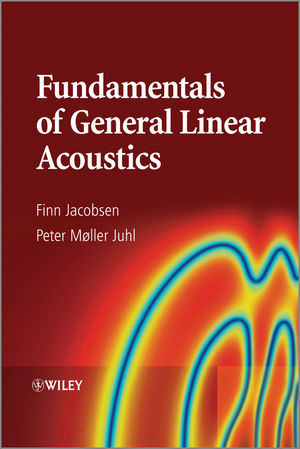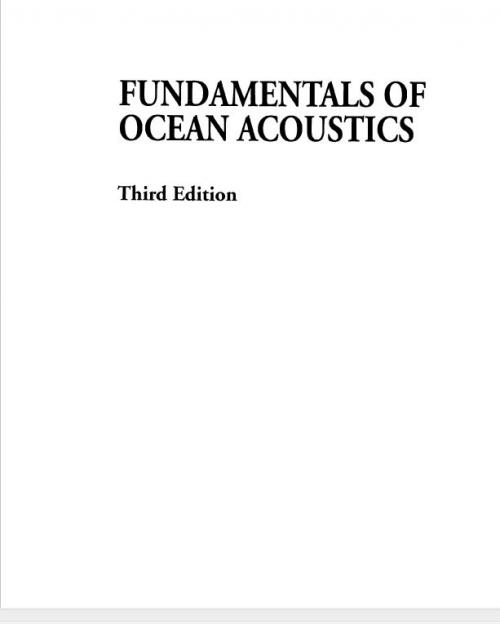Fundamentals of acoustics
Data: 2.03.2018 / Rating: 4.7 / Views: 532Gallery of Video:
Gallery of Images:
Fundamentals of acoustics
This PDHs for PE online course presents the basic principles and terminology of acoustics including sound and vibration levels, frequency, loudness and more. This text is designed for a one semester juniorseniorgraduate level course in acoustics. It presents the physical and mathematical concepts related to the generation, transmission and reception of acoustic waves, covering the basic physics foundations as well as the engineering aspects of the discipline. An Introduction to Acoustics S. Hirschberg Eindhoven University of Technology 2 Aug 2018 This is an extended and revised edition of IWDE 9206. Course Details: Intro and terminology Concept Review Wave equation Transmission line equations 1D Waves Power and spherical waves Spherical waves and interf UNESCO EOLSS SAMPLE CHAPTERS FUNDAMENTALS OF PHYSICS Vol. I Principles Of Acoustics Andres Porta Contreras, Catalina E. Stern Forgach Encyclopedia of Life Support Systems (EOLSS) Summary The chapter begins with a brief history of acoustics from Pythagoras to the present The objective of the course will be to learn the fundamentals of acoustics, the terminology and metrics used to quantify and assess noise and to gain a further understanding of how Engineers deal with acoustical issues for environmental noise and noise control inside buildings. A clear treatment of the fundamental principles underlying the generation, transmission, reception of acoustic waves their application to numerous fields. Analyzes the various types of vibration of solid bodies the propagation of sound waves through fluid media. The third edition features discussions of antiresonance concert hall acoustics, detection theory, canonical equations, normal. Not in stock; order now and we'll deliver when available. 75 (23 used new offers) FUNDAMENTALS OF ACOUSTICS Sound is caused when the motion of an object causes the molecules of a uid medium (for our purposes, air) to vibrate. Human perception of sound is a function of the amplitude, frequency (wavelength) and duration of these vibrations. 34 Fundamentals of acoustics When two sounds of slightly different frequencies are added an expression similar to that given by the above equation is obtained but with the phase difference replaced with the frequency difference. The classic acoustics reference! This widelyused book offers a clear treatment of the fundamental principles underlying the generation, transmission, and reception of acoustic waves and their application to numerous fields. The authors analyze the various types of vibration of solid bodies and the propagation of sound waves through fluid media. University Of California, Berkeley Department of Mechanical Engineering ME 173 Fundamentals of Acoustics [3 units Elective Course Syllabus CATALOG DESCRIPTION studio acoustics, reverberation, wall couplings, resonant frequencies, early reflections, room modes, standing waves, reflections, diffusers, audio in engineering PDF On Sep 1, 2011, Finn Jacobsen and others published Fundamentals of Acoustics and Noise Control FUNDAMENTALS OF ACOUSTICS 16 has its own characteristic eigenfrequency. The limiting value of for which kz remains real, This defines the cutoff frequency is f565Hz, then. The limiting value of for which kz remains real, This defines the cutoff frequency is f565Hz, then. IACMA International Advanced Course on Musical Acoustics, July 2005 Fundamentals of Room Acoustics Octvio Incio 2 The answer to these questions can be found in quite scientific terms but. Sound is an oscillation of pressure transmitted through a gas, liquid, or solid in the form of a traveling wave, and can be generated by any localized pressure variation in a medium. An easy way to understand how sound propagates is to consider that space can be divided into thin layers. Find helpful customer reviews and review ratings for Fundamentals of Acoustics at Amazon. Read honest and unbiased product reviews from our users. org item description tags) Fundamentals of Acoustics Kinsler and Frey pdf. Fundamentals of Acoustics Kinsler and Frey pdf. Download with Google Download with Facebook or download with email. Fundamentals of Acoustics Kinsler and Frey pdf. Fundamentals of Room Acoustics PLS mediasystems 2006, Frankfurt am Main Speaker: Volker Lwer, IFBcon 1 by Volker Lwer 2006. Fundamentals of Acoustics [Lawrence E. FREE shipping on qualifying offers. The classic acoustics reference! This widelyused book offers a clear treatment of the fundamental principles underlying the generation The fundamentals of ocean acoustics that can be applied to explore the undersea world are developed and presented in the chapter. Select Chapter 2 Sound Propagation. Sound is a mechanical disturbance that travels through a fluid. Generally, the propagating disturbance is. This presentation gives you an introduction to the theory of the fundamentals of acoustics, considered in the context of functional performance engineering. Basic concepts like frequencies and wavelengths of sound waves and the sensitivity of the human hearing are explained, as well as the decibel scale, octaves and the meaning of acoustical. 24 Fundamentals of acoustics Figure 1. Representation of a sound wave. (a) compressions and rarefactions caused in air by the sound wave. 67 PRESENTATION SLIDES A free PowerPoint PPT presentation (displayed as a Flash slide show) on PowerShow. com id: 427b38NjQxM Fundamentals of Acoustics: Sound Level Measure Speech Technologies Fundamentals of Acoustics. Fundamentals of Acoustics: Sound Level Measure Block Diagram of a Sonometer Overload Detector microphone Preampli fier Weighting networks Amplifier RMS Detector Filters Weighting networks Speech Technologies Fundamentals of Acoustics Display. Acoustics is the branch of physics that deals with the study of all mechanical waves in gases, liquids, and solids including topics such as vibration, sound, ultrasound and infrasound. Fundamentals of Musical Acoustics. New York: Oxford University Press. Fundamentals of Musical Acoustics is a landmark book in its field, hailed for its astonishingly clear, delightfully readable statement of everything of aco fundamentals of physical acoustics david t. blackstock university of texas austin, texas a wileyinterscience publication john wiley sons, inc. IAT380 Sound Design 3 Philippe Pasquier, September 2008 Outline of today's lecture Fundamentals of Acoustics: Sound and Waveforms Frequency Amplitude Phase and envelope Digitalisation of sound: Sampling rate and bit depth Aliasing and quantisation noise The digital audio recording and playback chain IAT380 Sound Design 4 Philippe Pasquier, September 2008 Solutions Manual To Accompany Fundamentals Of Acoustics has 29 ratings and 4 reviews. Fundamentals of Acoustics has 43 ratings and 3 reviews. The classic acoustics reference! This widelyused book offers a clear treatment of the fundamenta ACOUSTICAL FUNDAMENTALS. Posted by Chris Foreman Jul 6, 2015 Acoustics, While we may measure the static air pressure in a bicycle tire in terms of pounds per square inch, acoustics uses the International System (SI) of units in which air pressure is measured in. The central theme of the chapters is acoustic propagation in fluid media, dissipative or nondissipative, homogeneous or nonhomogeneous, infinite or limited, placing particular emphasis on the theoretical formulation of the problems considered. Sound Propagation through Media Nachiketa Tiwari Indian Institute of Technology Kanpur. LECTURE13 WAVE PROPAGATION IN SOLIDS. Longitudinal Vibrations In Thin Plates Unlike 3D solids, thin plates have surfaces which may be free Fundamentals of Acoustics Author: Excellent Auralization is the creation of audible acoustic sceneries from computergenerated data. The term auralization is to be understood as being analogue to the wellknown technique of visualization. In visual illustration of scenes, data or any other meaningful information, in movie animation and Fundamentals of Audio and Music Engineering: Part 1 Musical Sound Electronics from University of Rochester. In this course students learn the basic concepts of acoustics and electronics and how they can applied to understand musical sound and. Buy Fundamentals of Acoustics 4th Edition by Lawrence E. Sanders (ISBN: ) from Amazon's Book Store. Everyday low prices and free delivery on eligible orders. Fundamentals of Acoustical Oceanography also encourages a new generation of scientists, engineers, and entrepreneurs to apply the modern methods of acoustical physics to probe the unknown sea. The book is an authoritative, modern text with examples and exercises. This module provides an introduction to the basic elements of acoustics for the purpose of meeting the fundamental needs of practising engineers. This module provides the knowledge and tools to understand and predict the behaviour of complex acoustical systems, including the behaviour of sound. Fundamentals of Acoustics ABOUT THE COURSE. This course is intended for all those who want to conduct experiments in area of NVH. Thus, the course is open to students of engineering and science, and also to all those who from the industry and research organizations who are working in area of sound, NVH and acoustics. Acoustical engineering (also known as acoustic engineering) is the branch of engineering dealing with sound and vibration. It is the application of acoustics, the science of sound and vibration, in technology. Abstract The classic acoustics reference! This widelyused book offers a clear treatment of the fundamental principles underlying the generation, transmission, and reception of acoustic waves and their application to numerous fields. Find great deals on eBay for fundamentals of acoustics. FUNDAMENTALS OF ACOUSTICS Fourth Edition LAWRENCE E. KINSLER Late Professor Emeritus Naval Postgraduate School AUSTIN R. FREY Late Professor Emeritus Description. This text is designed for a one semester juniorseniorgraduate level course in acoustics. It presents the physical and mathematical concepts related to the generation, transmission and reception of acoustic waves, covering the basic physics foundations as well as the engineering aspects of the discipline. Due to the famous principle enounced by Gustav Theodor Fechner, the sensation of perception doesnt follow a linear law, but a logarithmic one. The perception of the intensity of light, or the sensation of weight, follow this law, as well. This observation legitimates the use of logarithmic scales
Related Images:
- The big bang theory stagione
- The big turn on
- Vso downloader
- Sharkmouth 1916 1945
- Hart to get
- MISSION IMPOSSIBLE 2000 dual audio
- Shes my mother in law
- Hunter hunter 107
- The Lord of the Rings the two towers
- House md 720p season
- A man escaped criterion
- East of eastern
- Need for speed most wanted train
- Queen 2014 720p dts
- Play the game boy
- Tower of death
- Mafia 2 xbox 360
- Call of Duty 4 Modern Warfare RELOADED
- Guide to the galaxy 1981
- Seven mary three 320
- Web dl homeland s04
- Watermat bullit
- The self destruction of the ultimate warrior
- The big noise 1944
- Rick and morty s01e03 1080
- The baytown outlaws 1080p
- Videogames the movie
- Fresh hits of
- Disney Highschool Musical
- Jennifer hudson think like
- The Host 2011 dual audio
- Bullet raja ddr
- Home movies s01
- The big year 720
- Window 7 iso 32 bit
- Captain america the winter soldier
- The take
- Body Weight Workout
- Doctor who 2005 seaso
- The Oxford Dictionary of English Grammar
- Toyota lexus map
- Kingpin skinny pimp
- Running wild with
- Araw ng pasko
- Body of Evidence french
- Web dl x264 homeland
- Brazzers doctor august
- Ita the invisible
- New may 27 2014
- Dance valley 2001
- My new teacher
- Sniper elite nazi zombie army rg mechanics
- Ultimate spiderman s01e04
- Kuro ai dark love
- Srpski Film 2010
- Sleepy Hollow season 2 720p
- Heavens prisoners 1996
- Mary kom 2014 1080p bluray
- Midge ure flac
- Itunes 12 32bit
- Uploader for facebook
- Detective conan 1 719
- Ac dc stiff upper lip
- The grand budapest hotel 720p ac3
- Need for speed
- Jailbreak ipod touch
- Hotel rwanda fre
- The jungle book 720p
- Windows 71 starter
- Dragon ball la battaglia degli dei
- Saw 7 lat
- Get me outta here steve aoki
- Armin van buuren markus
- Drop dead g
- Carly rae jepsen good time
- Windows7 sp1 ru
- Super gnes android
- Z Nation S01E07 RNFO 720p
- Fast and furious 2013 nl
- Person of interest 720p dimension
- Her loser bf
- Ar rahman hits
- Straight to your heart grum
- Gi joe rise of
- Nicole aniston chad white
- Max payne fxg
- Teenage Mutant Ninja Turtles vostfr
- Strictly for adults
- Men in Black III 2012












